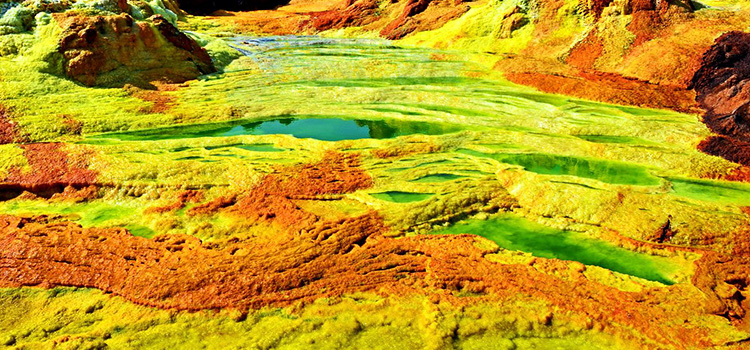Down the Danakil Depression
Ethiopia’s Danakil Depression. The hottest place on the earth with temperatures of 50°C and more than 100 meters below sea level, it is an otherworldly and inhospitable venture.
Ethiopia’s Danakil Depression. The hottest place on the earth with temperatures of 50°C and more than 100 meters below sea level, it is an otherworldly and inhospitable venture.
I was here in Spring of 2017, starting in South Sudan and flying down to Mekele. We drove over to this region of Northern Ethiopian and finished with the Simien Mountains. Because of the threat of attack I was with security escort the entire two weeks. As of now all travel here is not advised as a German tourist was just shot and killed by Eritrean rebels while visiting Erta Ale in December 2017.
This area of Northern Ethiopia is home to the Afar people, a nomadic tribe shepherding camels as a means of carrying salt to the Mekele market. Salt is their bread and butter, so the Afar make the daily trek 15 km and the weeklong journey to Mekele.
For me this was the most impressive aspect of this area, that humans can actually exist in such a brutal place. They are some of the toughest people I have met.
Because of a recent explosion of Erta Ale, the volcano had been closed since January so we were the first ones since it opened. It took a couple of hours up the sun side to get to the top and again, military escort were stationed at the top in case of an attack. The volcano is one of the most accessible on the planet. Brutal to be sure, but in all my travels, it’s one of the most unique places I have seen.
This Article was taken from here.
Visiting the Blue Nile Falls in Ethiopia
Coming over the hill one is engulfed in the splendour of one of Africa’s great sights, the Blue Nile falls in Ethiopia. If there was a heartbeat to the Nile River then the Blue Nile Falls …
Coming over the hill one is engulfed in the splendour of one of Africa’s great sights, the Blue Nile falls in Ethiopia.
If there was a heartbeat to the Nile River then the Blue Nile Falls would certainly be it. Many tributaries contribute to the Nile, but nearby Lake Tana is the main source.
The falls are located thirty or so miles south of Tana, and dramatically fall of a precipice creating a stunning scene, with a beautiful lush African backdrop.
Getting there one takes a bumpy dirt road deep into Ethiopia’s countryside. Through villages of farmers with their livestock, and donkeys and carts rolling along, an image of times gone by.
Once at the start of the trail to get to the falls you cross over and into a small village with children saying hello and displaying their various football teams t-shirts.
Heading further up the trail and over the top of a hill you get your first glimpse of the Blue Nile making a descent over the cliff.
Hiking further along the trail you will see the local people making their way to fields with their cattle. Joining with them in a fast pace to get closer to the falls you arrive at the best viewpoint directly opposite.
The thunderous roar of the falls is spectacular, and is best in the rainy season in august when there is much more water.
The article is taken from here


